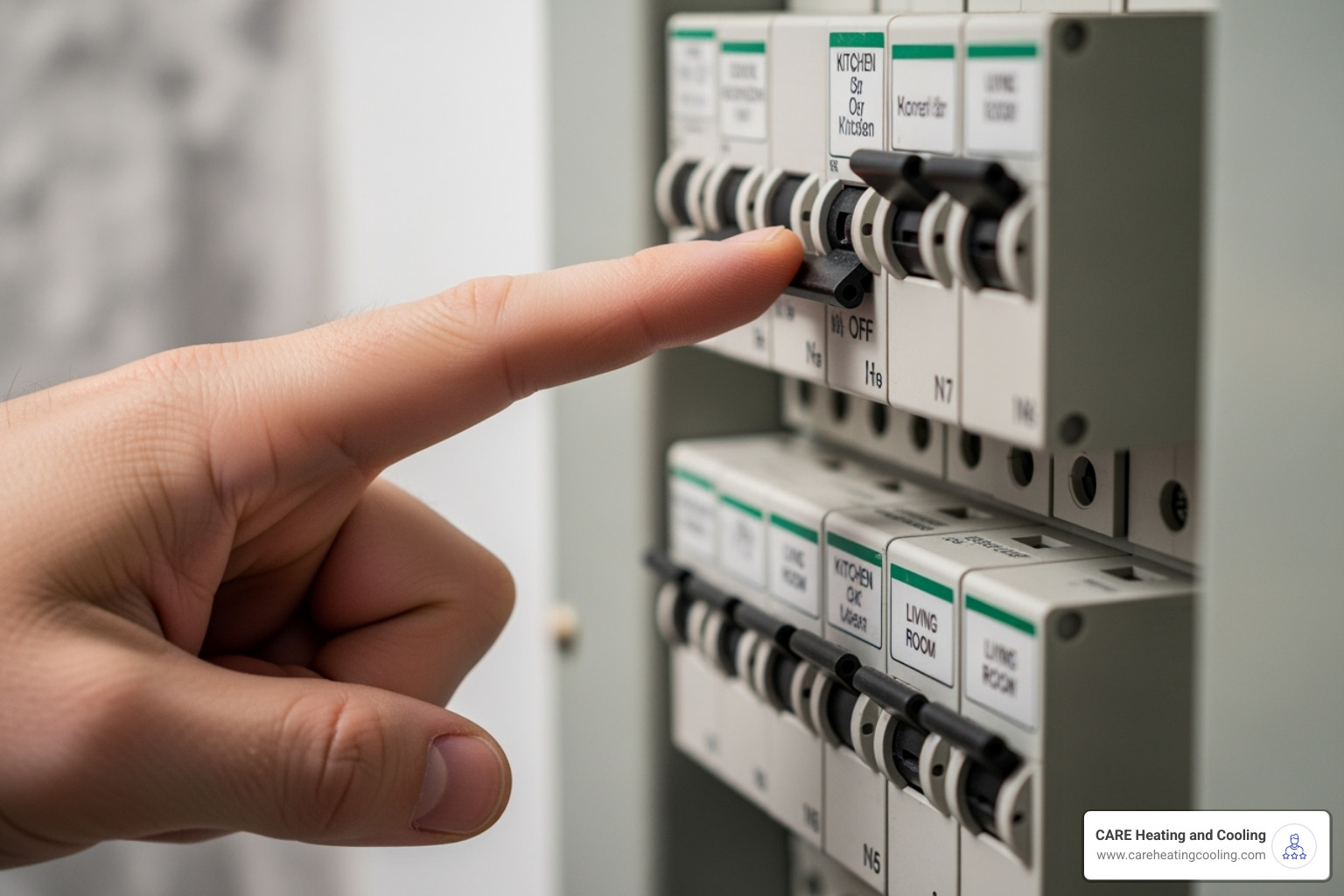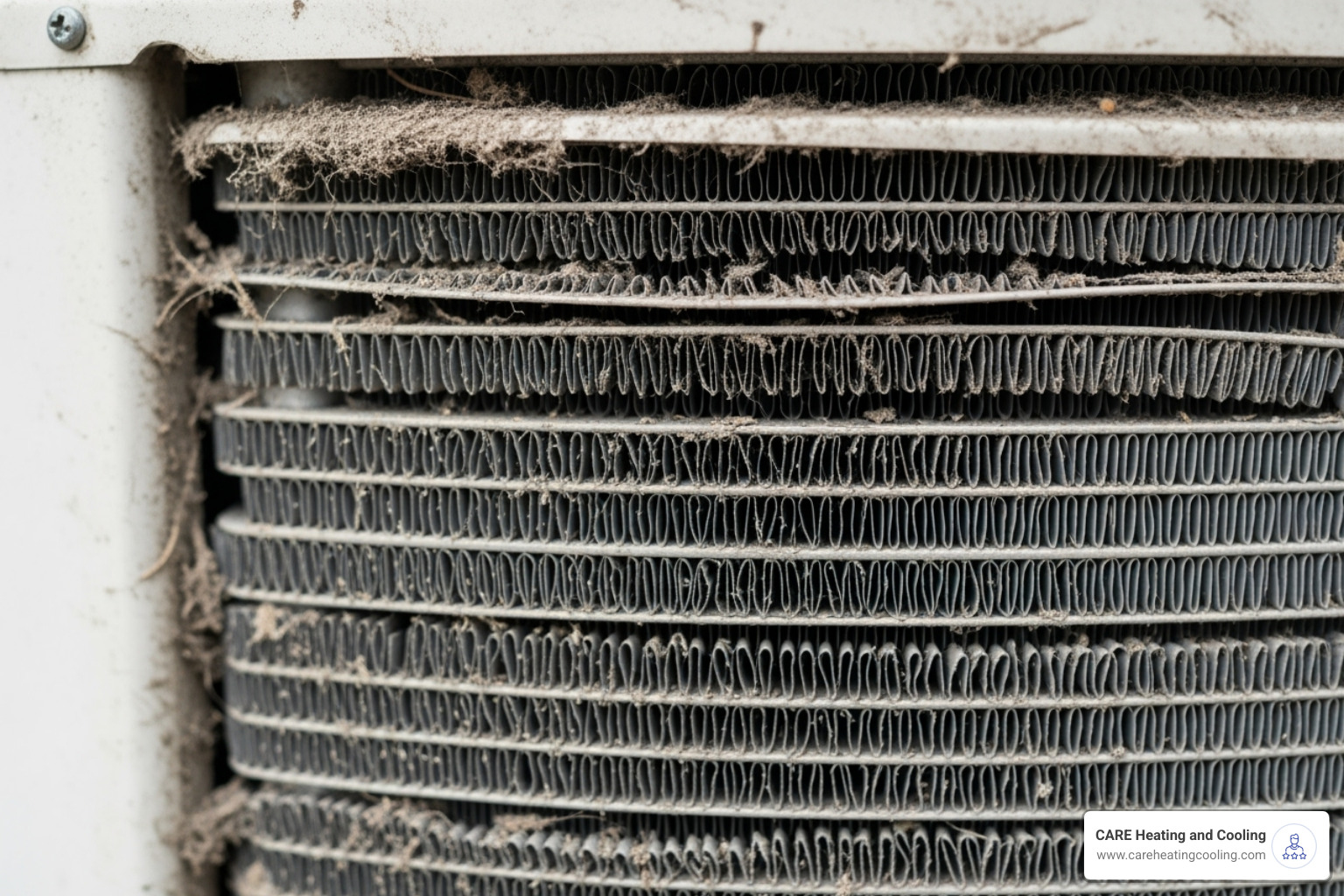When Your Home’s Cooling Heart Stops Beating
Nothing ruins a hot summer day like finding your AC compressor not starting. You flip the thermostat to cool, but instead of that familiar hum from your outdoor unit, you’re met with silence – and warm air flowing through your vents.
Quick troubleshooting checklist for AC compressor not starting:
- Check thermostat – Set to “cool” mode, temperature below room temp
- Verify power – Check circuit breaker and outdoor unit power switch
- Inspect air filter – Replace if dirty or clogged
- Look for ice – Check for frozen coils on indoor unit
- Listen for sounds – Note any humming, clicking, or grinding noises
- Check outdoor unit – Clear debris from around condenser
Your AC compressor is the heart of your cooling system. It’s the component that circulates refrigerant through your AC, creating the cooling process that keeps your home comfortable. When it fails to start, your entire air conditioning system stops working.
The compressor sits in your outdoor unit and works by compressing refrigerant gas, which then flows to the condenser coil to release heat. Without this crucial process, your AC becomes nothing more than an expensive fan blowing warm air.
Most homeowners can perform basic troubleshooting steps safely. However, issues involving electrical components, refrigerant, or internal compressor damage require professional attention due to safety risks and the specialized knowledge needed for proper diagnosis.
Find more about AC compressor not starting:
First Steps: Simple Troubleshooting a Homeowner Can Do
When your AC compressor is not starting and you’re facing another sweltering day, don’t panic just yet. Before calling for professional help, there are several straightforward checks you can perform yourself. These simple troubleshooting steps often reveal easy fixes that can get your cooling back on track without waiting for a service call.
Think of this as your AC detective work – we’re looking for the obvious culprits first before diving into the more complex possibilities.
Check Your Thermostat and Power
Your thermostat is like the conductor of your cooling orchestra – if it’s not giving the right signals, nothing else will work properly. Start by double-checking that your thermostat is set to “cool” mode and that the temperature setting is actually lower than your current room temperature. It sounds simple, but you’d be surprised how often this basic step gets overlooked.
Next, let’s make sure your system is getting power. Look for the main power switch near your indoor air handler – it should be in the “on” position. Then head to your breaker box and scan for any tripped breakers. A tripped breaker often sits halfway between “on” and “off” positions or may be fully switched to “off.” If you find one, flip it completely to “off” first, then back to “on.”
Don’t forget about fuses if your system uses them – a blown fuse will completely cut power to your AC. If a breaker keeps tripping repeatedly after you reset it, that’s your cue to call in the professionals.
One last power-related check: those fresh batteries in your thermostat. Dead or dying batteries can cause all sorts of mysterious behavior, from blank displays to failure to communicate with your outdoor unit. Swapping in new alkaline batteries takes just a minute and often solves communication problems.
Inspect Airflow and Filters
Your AC system needs to breathe freely to work properly, and restricted airflow is one of the most common reasons an AC compressor won’t start. When your system can’t move air efficiently, it works harder, runs hotter, and eventually may shut down completely to protect itself.
Start with your air filter – this hardworking component catches dust, pet hair, and other particles before they can clog up your system. Over time, a filter becomes so loaded with debris that it blocks airflow like a dam. Check your filter monthly and replace it every 45-90 days, or more frequently if you have pets or family members with allergies. A clogged filter forces your entire system to strain, which can lead to frozen coils and compressor problems.
For more detailed guidance on keeping your filters in top shape, check out this helpful resource on Air Conditioner Filter Replacement 101.
While you’re thinking about airflow, take a walk around your home and check that return grills aren’t blocked by furniture, curtains, or decorations. Your system needs clear paths to pull air in and push it back out.
Finally, step outside and inspect your outdoor unit. The area around your condenser should be clear of grass clippings, leaves, weeds, and other debris. Your outdoor unit needs at least two feet of clearance on all sides to properly release heat. When the condenser coils get blocked, your compressor has to work overtime, and that extra strain can eventually cause it to give up entirely.
If you’re still experiencing issues after these checks, you might want to explore our comprehensive AC Not Cooling Guide for additional troubleshooting steps.
Common Culprits: Why Your AC Compressor is Not Starting
After checking the basics, it’s time to explore the more common reasons behind an AC compressor not starting. These issues dig a bit deeper into how your cooling system actually works, but don’t worry – understanding them will help you know when it’s time to call us professionals.
The Impact of Dirty Coils and Filters
Here’s where things get interesting – and a little frustrating. Your AC system is actually designed to shut itself down when conditions aren’t right. It’s like a built-in safety net, but one that leaves you sweating when it kicks in.
When your air filter gets clogged, it’s not just about poor air quality. That restricted airflow means your indoor evaporator coil can’t absorb enough heat from your home’s air. The coil gets so cold it actually freezes over – yes, ice forms on your AC in the middle of summer! This freezing drops the refrigerant pressure dramatically, triggering your system’s low-pressure switch. Your compressor immediately shuts down to protect itself from damage.
Meanwhile, outside your home, dirty condenser coils create their own problems. These coils are supposed to release all that heat your AC pulled from inside. But when they’re covered in dirt, grass clippings, and debris, they can’t do their job. Heat gets trapped, refrigerant pressure skyrockets, and the high-pressure switch steps in to shut everything down before your compressor overheats.
Both scenarios lead to the same frustrating result: an AC compressor not starting, all because your system is trying to protect itself. The good news? Regular cleaning and filter changes prevent most of these issues. For a deeper dive into filter problems, check out this helpful article on dirty filters.
Understanding a Failed Capacitor or Starter Relay
If you hear humming or clicking sounds when your AC tries to start, or if your outdoor fan spins but the compressor stays silent, you’re likely dealing with a failed capacitor or starter relay. These small components pack a big punch in getting your system running.
Think of a capacitor as your compressor’s personal trainer – it provides that initial energy jolt needed to get the motor spinning. Without it, your compressor is like a car with a dead battery. It wants to start, it tries to start (hence the humming), but it just can’t get going.
Most modern AC units use a dual-run capacitor that handles both the compressor and the outdoor fan. Here’s the tricky part: one side can fail while the other keeps working perfectly. That’s why you might see your fan spinning cheerfully while your compressor sits there humming in frustration.
The starter relay acts like a messenger, telling the capacitor when to send power to the compressor. When it fails, you’ll often hear clicking sounds as it tries unsuccessfully to complete the connection. It’s like having a doorbell that rings but never actually opens the door.
These components deal with high voltage and can be dangerous to replace without proper training. If you suspect a capacitor or relay issue, it’s time to call us. We handle these repairs safely and efficiently. Learn more about this common problem on our AC Capacitor Replacement page.
Deeper Diagnostics: Electrical and Refrigerant System Issues
When basic troubleshooting doesn’t solve your cooling crisis, we’re venturing into more complex territory. These deeper issues typically involve the electrical system or refrigerant components – areas that require specialized knowledge and tools to diagnose properly.
The Critical Role of Refrigerant
Think of refrigerant as the lifeblood flowing through your AC system. This specialized fluid absorbs heat from inside your home and carries it outside, where it releases that heat into the outdoor air. Your compressor acts like the heart in this process, pumping and pressurizing the refrigerant to keep it circulating.
For your system to work properly, refrigerant levels need to be precisely right – like Goldilocks’ porridge, not too much and not too little. When refrigerant levels drop too low, usually due to a refrigerant leak somewhere in the system, your AC compressor not starting becomes a protective response rather than a malfunction.
Here’s what happens: when refrigerant levels fall below safe operating levels, the low-pressure switch kicks in and shuts down the compressor. This fail-safe mechanism prevents your compressor from running dry, which would cause expensive internal damage. We typically see these switches trigger when pressure drops below 40 psi.
On the flip side, high refrigerant levels or blockages that cause pressure buildup will activate the high-pressure switch, usually around 450 psi. Again, this is your system protecting itself from dangerous operating conditions.
One telltale sign of refrigerant trouble is frost on the suction line – that’s the larger, insulated pipe running between your indoor and outdoor units. This icy buildup often signals low refrigerant or airflow problems.
Refrigerant handling isn’t a DIY job. These chemicals require special licensing and equipment to handle safely. If you suspect refrigerant issues, it’s time to call professionals who can properly diagnose and repair the problem. For more detailed information, check out our guide on AC Refrigerant Leak Detection and Repair.
Electrical Problems That Cause an AC Compressor Not to Start
Beyond capacitors and relays, a whole world of electrical gremlins can prevent your AC compressor not starting. These issues involve high voltage and complex circuits that demand professional expertise for safe diagnosis and repair.
Faulty wiring tops our list of electrical troublemakers. Years of weather exposure, vibration, and sometimes hungry critters can damage wires, creating loose connections or complete breaks in the electrical pathway. If you notice a burning smell or see scorch marks around electrical connections, that’s your cue to shut off power immediately and call for help.
Low voltage supply can also starve your compressor of the power it needs to start. During peak summer demand, your home’s electrical supply might dip below the minimum requirements. When voltage drops more than 10% below normal levels, your compressor motor struggles to start and can suffer long-term damage from the strain.
The worn contactor is another common culprit. This electrical switch delivers power to your compressor and outdoor fan when your thermostat calls for cooling. Over time, these contacts can become pitted, stick, or fail to engage properly, cutting off power to your compressor entirely.
Sometimes the problem lies within the compressor motor itself. Shorted windings occur when the insulation around internal copper wires breaks down, causing electrical shorts. Grounded windings happen when these wires touch the compressor’s metal casing, creating dangerous electrical paths. Damaged wires inside the motor can also create open circuits that prevent proper operation.
Unfortunately, most modern compressors are hermetically sealed units. This means if internal electrical problems develop, the entire compressor typically needs replacement rather than repair.
Given the high voltage involved and the complexity of electrical diagnosis, these repairs are definitely in professional territory. The risks of injury or equipment damage are simply too high for DIY attempts.
Knowing When to Call for Professional Help
We completely understand the satisfaction that comes from fixing things around the house yourself. There’s something deeply rewarding about solving a problem with your own two hands. However, when it comes to your AC compressor not starting, there’s a crucial line between safe DIY troubleshooting and potentially dangerous territory that requires professional expertise.
Think of it this way: we wouldn’t attempt brain surgery after watching a few YouTube videos, and the same principle applies to complex HVAC repairs. While we’ve covered several troubleshooting steps you can safely perform, certain warning signs should have you reaching for the phone instead of your toolbox.
Loud grinding noises coming from your outdoor unit are like your AC screaming for help. These sounds often indicate serious mechanical problems within the compressor or fan motor – components that contain high-pressure refrigerant and operate under significant electrical loads. Similarly, any burning smells should immediately send you to your electrical panel to shut off power to the unit. That acrid odor could signal overheating wires, failing electrical components, or worse.
If your circuit breaker repeatedly trips after you reset it, your AC is trying to tell you something important. A breaker that keeps flipping off is doing its job – protecting your home from electrical hazards. Ignoring this warning and continuing to reset it could lead to electrical fires or serious damage to your system.
The reality is that modern AC systems involve high voltage components that can seriously injure or kill an untrained person. Professional HVAC technicians undergo extensive training not just to diagnose problems, but to work safely around these dangerous systems. We carry specialized tools, understand electrical safety protocols, and know how to handle refrigerant – a substance that requires licensing to work with legally.
At CARE Heating and Cooling, we’ve built our reputation on being the technicians you can trust. We’re proud recipients of the BBB Torch Award for Ethics, and here’s what sets us apart: our technicians are paid to fix your equipment, not to sell you new systems. This means when we arrive at your home, our focus is genuinely on getting your existing system running efficiently again.
We know that calling for professional help can feel like admitting defeat, especially when you’ve invested time in troubleshooting. But think of it as calling in reinforcements when the job requires specialized skills and equipment. Our goal is to diagnose the real problem quickly and fix it right the first time, saving you both frustration and money in the long run.
For a comprehensive look at the various issues we regularly solve for homeowners, visit our guide on Common AC Repair Issues Expert Solutions. When in doubt, it’s always better to be safe than sorry – especially when it comes to your family’s comfort and safety.
Frequently Asked Questions about a Non-Starting AC Compressor
When your cooling system decides to take an unexpected vacation, we know the questions start flying. After years of helping homeowners get their comfort back, we’ve heard just about every question imaginable about AC compressor not starting issues. Let’s tackle the most common ones together.
What are the first signs of a failing AC compressor?
Your compressor rarely fails without warning – it usually gives you hints that trouble is brewing. Think of these signs as your AC’s way of asking for help before it completely gives up.
Unusual noises are often the first red flag. That familiar, steady hum you’re used to hearing might change to something more concerning. Grinding sounds usually mean internal parts are wearing against each other. Squealing often points to belt or bearing issues. Rattling or clunking noises suggest loose components bouncing around inside the unit. None of these sounds are normal, and they’re your compressor’s cry for attention.
Reduced cooling performance is another telltale sign. If your AC is running but your home feels more like a sauna than the cool oasis you’re paying for, your compressor might be struggling. Sometimes this shows up as warm air blowing from your vents instead of the refreshing cool air you expect. Our AC Blowing Hot Air guide dives deeper into this frustrating problem.
Frequent circuit breaker trips happen when your compressor is working too hard or drawing more electricity than it should. Your electrical system is trying to protect itself – and your home – by cutting power when something’s not right. If you find yourself repeatedly resetting the same breaker, your compressor is likely sending an SOS signal.
You might also notice higher energy bills creeping up month after month. A struggling compressor has to work overtime to do its job, and that extra effort shows up on your electric bill. When your system becomes less efficient, your wallet feels it first.
Can a bad capacitor make the fan run but not the compressor?
Absolutely! This scenario is actually one of the most common situations we encounter, and it perfectly illustrates how interconnected yet separate your AC components can be.
Most AC units use what’s called a dual-run capacitor – think of it as a two-in-one power booster. This single component has separate terminals that serve both your compressor motor and your condenser fan motor. It’s entirely possible for the fan side of the capacitor to keep working perfectly while the compressor side fails completely.
When this happens, you’ll see your outdoor fan spinning away happily while hearing nothing but silence – or maybe a frustrated humming sound – from the compressor. The compressor tries to start, drawing power and making that telltale hum, but without the electrical kick from its side of the capacitor, it just can’t overcome its initial resistance to get going.
This is actually good news in disguise. It means your compressor isn’t necessarily damaged – it might just need a new capacitor to get back to work. However, diagnosing and replacing capacitors involves high voltage, so it’s definitely a job for our trained technicians.
How do I reset my AC compressor?
Sometimes your compressor shuts down as a protective measure, and a simple reset can bring it back to life. It’s like giving your system a fresh start after it encountered a problem.
Start by turning off your thermostat completely – set it to the “off” position rather than just raising the temperature. Next, head to your home’s electrical panel and turn off power at the breaker. Look for the switch labeled for your outdoor AC unit or HVAC system and flip it to “off.” This completely cuts power to your outdoor unit.
Some AC units have a small reset button directly on the outdoor unit itself. It’s usually red and might be located near the bottom of the unit, on the back, or sometimes inside a small access panel. If you find one, press and hold it for about 3-5 seconds. Don’t worry if you can’t find one – not all units have this external reset feature.
Now comes the important part: wait 30 minutes. We know it’s tempting to rush this step, especially on a hot day, but this waiting period is crucial. It allows your compressor’s internal safety switches to cool down and reset, and gives your system time to balance out refrigerant pressures throughout the lines.
After your patient wait, restore power at the breaker by flipping it back to “on,” then turn on your thermostat and set it to cool mode with a temperature below your current room temperature. Listen for your compressor to start up with its familiar hum.
If your system doesn’t start after this reset, or if the breaker trips again immediately, it’s telling you there’s a deeper problem that needs our professional attention. Sometimes a reset works like magic, and sometimes it confirms that your system needs expert care to get back to keeping you cool.
Get Your Cool Back: The Final Step
Dealing with an AC compressor not starting can feel overwhelming, especially when summer heat is beating down on your home. We’ve walked through this journey together – from the simple fixes like checking your thermostat and replacing dirty filters, to understanding the more complex world of capacitors, refrigerant levels, and electrical components.
The truth is, there’s quite a bit we can accomplish on our own. Those basic troubleshooting steps we covered can often get your system humming again without any outside help. But here’s what we’ve learned along the way: knowing when to stop is just as important as knowing where to start.
Professional diagnosis becomes essential when we’re dealing with high voltage electrical components, refrigerant handling, or internal compressor damage. These aren’t just technical challenges – they’re genuine safety risks that require specialized tools and years of training to handle properly.
At CARE Heating and Cooling, we’ve built our reputation on doing right by our customers. Our technicians earn their pay by fixing your units, not by pushing unnecessary replacements. When we show up at your door, you can trust that we’re there to solve your problem, not create bigger ones. That BBB Torch Award for Ethics isn’t just sitting on our wall for decoration – it represents our daily commitment to honest, customer-focused service.
Here’s something that might surprise you: regular maintenance is your best defense against an AC compressor not starting in the first place. A well-maintained air conditioner with proper care can keep its compressor running strong for 10-15 years. Those yearly maintenance visits aren’t just about changing filters – they’re about catching small issues before they turn into major headaches on the hottest day of the year.
Think of it this way: we can spot a struggling capacitor or notice early signs of refrigerant loss during a routine visit, addressing these problems when they’re still manageable. It’s much easier (and more comfortable) than waiting for your system to give up completely during a heat wave.
When your AC compressor not starting has you feeling the heat, help is just a phone call away. We’re here to restore your comfort quickly and safely, so you can get back to enjoying your cool, comfortable home.











